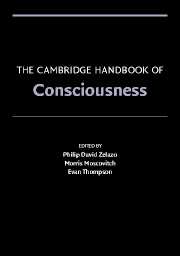
-
Select format
-
- Publisher:
- Cambridge University Press
- Publication date:
- June 2012
- May 2007
- ISBN:
- 9780511816789
- 9780521857437
- 9780521674126
- Dimensions:
- (253 x 177 mm)
- Weight & Pages:
- 1.802kg, 998 Pages
- Dimensions:
- (253 x 177 mm)
- Weight & Pages:
- 1.636kg, 998 Pages
- Subjects:
- Philosophy of Mind and Language, Philosophy, Psychology, Psychology: General Interest, Cognition
- Collection:
- Cambridge Handbooks of Psychology
You may already have access via personal or institutional login- Subjects:
- Philosophy of Mind and Language, Philosophy, Psychology, Psychology: General Interest, Cognition
- Collection:
- Cambridge Handbooks of Psychology
Book description
The Cambridge Handbook of Consciousness is the first of its kind in the field, and its appearance marks a unique time in the history of intellectual inquiry on the topic. After decades during which consciousness was considered beyond the scope of legitimate scientific investigation, consciousness re-emerged as a popular focus of research towards the end of the last century, and it has remained so for nearly 20 years. There are now so many different lines of investigation on consciousness that the time has come when the field may finally benefit from a book that pulls them together and, by juxtaposing them, provides a comprehensive survey of this exciting field. An authoritative desk reference, which will also be suitable as an advanced textbook.
Reviews
"This volume provides readers from many disciplines with the foundation and knowledge to date on the very comprehensive and complex study of consciousness."
--Janet L. Etzi, PsycCRITIQUES
"...the breath of coverage is impressive....a useful resource....In sum, the book displays how thoroughly our dualistically oriented culture's scientific investigation of human behavior is held in the grip of ancient traditional constructs that are imposed on observed events..."
--Noel W. Smith, State University of New York at Plattsburg, The Psychological Record
Contents
Metrics
Altmetric attention score
Full text views
Full text views help Loading metrics...
Loading metrics...
* Views captured on Cambridge Core between #date#. This data will be updated every 24 hours.
Usage data cannot currently be displayed.
Accessibility standard: Unknown
Why this information is here
This section outlines the accessibility features of this content - including support for screen readers, full keyboard navigation and high-contrast display options. This may not be relevant for you.
Accessibility Information
Accessibility compliance for the PDF of this book is currently unknown and may be updated in the future.


